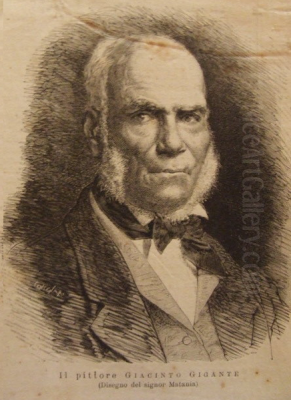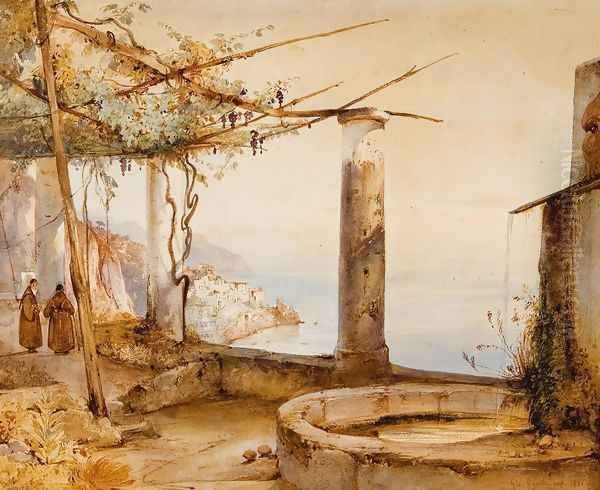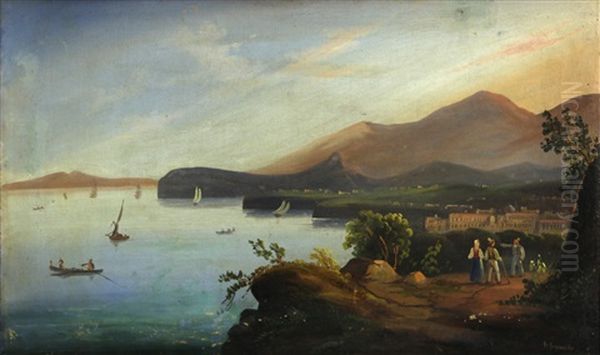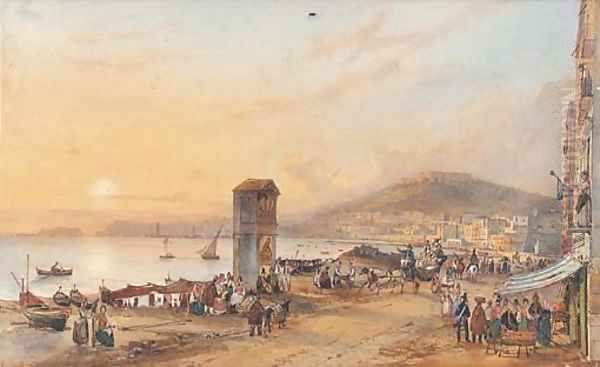
Giacinto Gigante (1806-1876) stands as a pivotal figure in 19th-century Italian art, particularly renowned for his evocative landscape paintings. Born and primarily active in Naples, Gigante became a leading exponent of the School of Posillipo, a movement celebrated for its fresh, naturalistic approach to depicting the stunning scenery and vibrant light of Southern Italy. His work skillfully bridges the gap between classical landscape traditions and the burgeoning spirit of Romanticism, leaving behind a legacy of luminous watercolors and oils that continue to captivate viewers with their atmospheric beauty and technical brilliance.
Early Life and Artistic Formation
Giacinto Gigante was born in Posillipo, Naples, in 1806, into a family with artistic inclinations. His initial training in art came from his father, Gaetano Gigante, who was also a painter. This early exposure within the family home laid the foundation for his future career. In 1818, Giacinto began his formal artistic education, signaling a more serious commitment to developing his craft during a period of rich cultural activity in Naples.
Around 1820, seeking to broaden his skills, Gigante, alongside his friend Achille Vianelli (who would also become a notable painter), began visiting the studio of Jakob Wilhelm Huber. Huber, a German painter residing in Naples, introduced Gigante to more advanced techniques. Under Huber's guidance, Gigante honed his skills in watercolor painting and learned about perspective aids, possibly including the use of the camera lucida or similar devices to achieve topographical accuracy, a practice not uncommon at the time.
Further diversifying his technical abilities, Gigante gained employment at the prestigious Royal Topographical Office (Real Officio Topografico) in Naples. This experience proved invaluable, providing him with practical training in the arts of etching and lithography. Mastery of these printmaking techniques likely influenced his later painting style, perhaps contributing to the clarity of line and compositional structure sometimes evident in his landscape work. This period grounded his artistic practice in careful observation and precise rendering.
The Influence of Pitloo and the School of Posillipo

A defining influence on Giacinto Gigante's artistic direction was the Dutch painter Antoon Sminck van Pitloo. Pitloo had settled in Naples and became a central figure in the city's art scene, eventually founding the School of Posillipo. This informal school or movement gathered artists who sought to break away from the rigid Neoclassical traditions that still dominated academic painting.
Between 1822 and 1824, Gigante frequented Pitloo's studio. Pitloo championed the practice of painting en plein air (outdoors), encouraging artists to capture the immediate effects of light and atmosphere directly from nature. This approach resonated deeply with Gigante, steering him decisively towards landscape painting as his primary genre. Pitloo's emphasis on direct observation and capturing the transient qualities of the natural world profoundly shaped Gigante's artistic philosophy.
The School of Posillipo, with Gigante as one of its most distinguished members, became known for its intimate and luminous depictions of the Bay of Naples, the surrounding countryside, and local life. The artists associated with this school shared a common interest in studying the effects of natural light and shadow, rendering the unique golden haze and clear Mediterranean light that characterized the region. They moved away from idealized, historical landscapes towards more personal, observed views, infused with a sense of place and atmosphere. Gigante's work came to epitomize these qualities.
Artistic Style and Techniques
Giacinto Gigante's mature artistic style represents a masterful synthesis of inherited traditions and innovative practices. While grounded in the careful observation associated with topographical and classical landscape painting, his work is imbued with the emotional sensitivity and atmospheric focus characteristic of Romanticism. His deep affection for the natural beauty of the Neapolitan region is palpable in his canvases.
A hallmark of Gigante's style is his extraordinary ability to capture the nuances of light and shadow. He was particularly adept at rendering the specific atmospheric conditions of Southern Italy – the bright coastal sunlight, the soft haze over the bay, the dramatic contrasts of light at dawn or dusk. His paintings often possess a luminous quality, achieved through careful tonal gradations and a vibrant, yet controlled, palette.

Gigante excelled in the medium of watercolor, developing a technique sometimes referred to as "mezzo-tempera" or demonstrating a unique approach that combined the transparency of watercolor with the opacity and richness closer to gouache or tempera, allowing for both delicate washes and more substantial forms. His brushwork could be both precise and spontaneous, enabling him to quickly capture fleeting effects of light and weather. This technical facility distinguished him and contributed significantly to the fresh, immediate feel of many of his works.
His training in topography and perspective is evident in the sound compositional structure of his landscapes. Gigante often employed linear perspective effectively to create convincing illusions of depth and space, drawing the viewer into the scene. However, this structural underpinning was always subservient to the overall atmospheric effect, ensuring his paintings felt natural rather than rigidly constructed.
Furthermore, Gigante was known for his experimental and rich use of color. He wasn't afraid to use bold hues to convey the intensity of the Mediterranean light and landscape, moving beyond the more subdued palettes often favored by earlier landscape traditions. His sensitivity to color relationships allowed him to create works that were both visually striking and emotionally resonant, capturing the unique chromatic character of places like Pompeii, Amalfi, and the Bay of Naples.
Key Themes and Representative Works
The primary focus of Giacinto Gigante's art was the landscape and scenery of Naples and its surrounding regions. He painted numerous views of the Bay of Naples, Mount Vesuvius, the islands of Capri and Ischia, the Amalfi Coast, and the ancient ruins of Pompeii and Herculaneum. His work provides a valuable visual record of Southern Italy in the 19th century, capturing not just the famous landmarks but also quieter corners and scenes of local life.
Among his significant early works is Lago Lucino (Lake Lucrino), which is noted as marking the beginning of his professional career and influencing Neapolitan landscape painting. This piece likely demonstrated his early mastery of capturing local scenery with a fresh perspective.
His painting Amalfi showcases his ability to handle complex compositions and unique viewpoints. It depicts the Capuchin monastery perched above the town, viewed distinctively from sea level, offering a comprehensive panorama that encompasses the water, the cliffs, and the architecture, all bathed in characteristic coastal light.

Gigante's fascination with the archaeological sites near Naples is evident in works like Vista di Pompei (View of Pompeii) and Casa dei Capitelli Colorati (House of the Coloured Capitals, Pompeii). These paintings go beyond mere topographical records; they capture the poignant atmosphere of the ruins, often highlighting the interplay of sunlight and shadow across the ancient structures and frescoes, demonstrating his keen eye for light's effects.
Another notable work, Tempio di Venere (Temple of Venus), depicts the ruins at Baiae. This piece exemplifies his attention to detail within a broader landscape context, carefully rendering the architectural forms while simultaneously capturing the surrounding natural environment and its specific atmospheric quality.
Beyond grand landscapes and ruins, Gigante also depicted scenes of everyday Neapolitan life. La Casa Delle Servette di Napoli (The House of the Maidservants of Naples), a watercolor, offers a glimpse into the domestic spaces and daily routines of the city's inhabitants, showcasing his versatility and interest in genre scenes.
Gigante also undertook significant commissions. He produced a series of works, possibly compiled under a title like Viaggio in due regni della Sicilia (Travels in the Two Kingdoms of Sicily), likely commissioned during a trip sponsored by the Russian Empress Alexandra Feodorovna. This project involved creating a collection of landscapes documenting the island.
Other important commissions included two large paintings depicting the Neapolitan countryside for the Russian Empress, showcasing his favor with international patrons. He was also commissioned by King Victor Emmanuel II to create a watercolor painting inside the Chapel of San Gennaro in Naples Cathedral, a prestigious task highlighting his standing. Later in his career, in 1863, he received the commission for an altarpiece for the Naples Cathedral itself.
Connections and Collaborations
Giacinto Gigante's artistic journey was shaped by interactions with numerous other artists. His father, Gaetano Gigante, provided his initial instruction. His formative years were significantly influenced by his studies with the German painter Jakob Wilhelm Huber and, most importantly, the Dutch artist Antoon Sminck van Pitloo, the guiding spirit of the School of Posillipo. Gigante's friend from his youth, Achille Vianelli, shared some of his early training experiences.
A particularly fruitful relationship was his close friendship with the Russian landscape painter Sylvester Shchedrin, who also worked in Naples. This connection proved highly beneficial, opening doors for Gigante to receive commissions from affluent Russian aristocrats visiting or residing in Italy. Shchedrin's presence in Naples further enriched the international artistic milieu from which Gigante drew inspiration.

Gigante's artistic family extended to his own siblings. His brothers, Achille Gigante and Ermichele Gigante, were also landscape painters associated with the School of Posillipo, contributing to the family's significant presence within the Neapolitan art scene. This familial artistic environment undoubtedly fostered a supportive and stimulating atmosphere for his development.
Additionally, some accounts mention the influence of the technical painting practices associated with Jacob Philippe Hackert, an earlier German landscape painter who had worked extensively in Naples for the Bourbon court. Hackert's detailed and sometimes more objective style might have provided a counterpoint or foundation upon which Gigante built his more atmospheric and romantic approach. The artists directly mentioned in the source materials as influencing or interacting with Gigante include: Gaetano Gigante, Jakob Wilhelm Huber, Achille Vianelli, Antoon Sminck van Pitloo, Sylvester Shchedrin, Achille Gigante, Ermichele Gigante, and Jacob Philippe Hackert.
Career Milestones and Later Life
Giacinto Gigante achieved considerable success and recognition during his lifetime. His skills, particularly in watercolor and landscape, quickly established his reputation within Naples and beyond. His association with the School of Posillipo placed him at the forefront of a popular and influential artistic movement.
His connections with the Russian community in Italy, facilitated by his friendship with Shchedrin, led to significant patronage. The commission from Empress Alexandra Feodorovna to travel to Sicily and document its landscapes was a major undertaking. The subsequent large paintings of the Neapolitan countryside further cemented his reputation among international collectors.
Royal and noble patronage within Italy also marked his career. He served for a time as a drawing master or painter to a Neapolitan princess (the specific identity varies in sources, but the connection to the court is noted). The commission from King Victor Emmanuel II for the watercolor in the San Gennaro Chapel was another mark of high esteem.
Academic recognition came in 1855 when Gigante was appointed Professor at the Naples Academy of Fine Arts (Accademia di Belle Arti di Napoli). This position acknowledged his mastery and influence, allowing him to formally pass on his knowledge and approach to a new generation of artists.
The political turmoil of the era impacted his life. Following the outbreak of the revolution in 1848, Gigante reportedly left Naples for a period, spending time in Rome where he continued his artistic activities, including teaching. While the exact duration and circumstances of this period relative to his later Naples professorship require careful historical interpretation, it reflects the turbulent times in which he lived.
Gigante remained artistically active throughout his later years. The commission for the Naples Cathedral altarpiece in 1863 indicates his continued prominence. He dedicated himself to his art, meticulously organizing his personal collection of works, until his death in Naples in 1876.
Legacy and Conclusion
Giacinto Gigante remains one of the most important Italian landscape painters of the 19th century and the undisputed star of the School of Posillipo. His work represents a high point in the depiction of Neapolitan scenery, capturing its unique light, atmosphere, and beauty with unparalleled sensitivity and skill.
His primary contribution lies in his ability to infuse topographical accuracy with romantic feeling and a masterful handling of light and color. He elevated the genre of landscape painting in Naples, moving beyond picturesque conventions to create works of genuine artistic merit and emotional depth. His watercolors, in particular, are celebrated for their freshness, luminosity, and technical innovation.
Through his paintings and his role as a professor at the Naples Academy, Gigante influenced subsequent generations of artists in Southern Italy. He helped solidify the importance of direct observation from nature and demonstrated how watercolor could be used as a major medium for finished artworks, not just preparatory sketches.
Today, Giacinto Gigante's paintings are held in major museums and private collections worldwide. They continue to be admired for their aesthetic beauty and as precious documents of the landscapes and life of Southern Italy during a transformative period in its history. His legacy endures as a master interpreter of the Neapolitan light and soul.